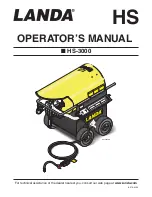
DEFINITION OF USE
• Keep these Instructions for Use and the
Programme Chart; if you pass on the washing
machine to another person, also give him/her
Instructions for Use and Programme Chart.
This washing machine is exclusively destined to wash
and spin machine washable laundry in quantities which
are usual for private households.
• Observe the instructions given in these Instructions
for Use and the Programme Chart when using the
washing machine.
BEFORE USING THE WASHING MACHINE
1. Remove the packaging and check
a.
Cut and remove the shrink-wrap.
b.
Remove the top protection and the protective
corners.
c. Remove the bottom protection by tilting
and turning the washing machine on one
rear bottom corner. Make sure that the
black plastic part of the bottom protection
(if available on the model) remains in the
packing and not in the machine bottom.
This is important, as otherwise the plastic part could
damage the washing machine during operation.
d.
Open the lid by pressing it slightly down while
raising the handle. Remove the polystyrene
cushion (depending on model).
e.
Remove the blue protective film from the panel
(depending on model).
• After unpacking, make sure that the washing machine
is undamaged. If in doubt, do not use the washing
machine. Contact After-Sales Service or your local
retailer.
• Keep the packaging materials (plastic bags,
polystyrene parts, etc.) out of reach of children;
they are potentially dangerous.
• If the appliance was exposed to the cold prior to
delivery, keep it at room temperature for a few
hours before operating.
2. Remove the transport bracket
• The washing machine is fitted with transport
screws and a transport bracket to prevent
damage during transport.
Before using the
washing machine you must remove the
transport bracket
(see “Installation”/“Removal
of transport bracket”).
3. Install the washing machine
• Place the washing machine on a flat and stable
floor surface.
•
Adjust the feet to ensure that the machine is
stable and level (see “Installation”/“Adjust the
feet”).
• In case of wooden or so-called “floating floors”
(for instance certain parquet or laminate floors),
place the appliance on a 40 x 60 cm sheet of
plywood at least 3 cm in thickness which is
secured to the floor.
• Make sure that the ventilation openings in the
base of your washing machine (if available on
your model) are not obstructed by a carpet or
other material.
4. Water supply
• Connect the water supply inlet hose in
accordance with the regulations of your local
water company (see “Installation”/“Connect the
water inlet hose”).
• Water supply: Cold water only
• Tap: 3/4” threaded hose connection
• Pressure: 100-1000 kPa (1-10 bar).
• Only use new hoses for connecting the washing
machine to the water supply. Used hoses must
not be used anymore and should be discarded.
5. Drain hose
• Connect the drain hose to the siphon or hook it
over the edge of a sink with the “U” bend (see
“Installation”/“Connect the water drain hose”).
• If the washing machine is connected to a built-in
drainage system, ensure the latter is equipped
with a vent to avoid simultaneous loading and
draining of water (siphoning effect).
6. Electrical connection
• Electrical connections must be carried out by a
qualified technician in compliance with the
manufacturer’s instructions and the current
standard safety regulations.
• The technical data (voltage, power and fuses) are
given on the rating plate on the rear of the washing
machine.
• The washing machine must be connected exclusively
by means of a socket with an earth connection in
accordance with current regulations. The washing
machine must be earthed by law. The manufacturer
declines all liability for injury to persons or animals or
damage to property deriving directly or indirectly
from failure to observe the directions.
• Do not use extension leads or multi sockets.
• Before any maintenance on the washing machine
disconnect it from the mains supply.
• Access to the mains plug or to disconnection from
the mains supply via a double-pole switch must be
ensured at all times following the installation.
• Do not operate the washing machine if it has been
damaged during transport. Inform the After-Sales
Service.
• Mains cable replacement is only to be carried out
by After-Sales Service.
• The washing machine must be connected to an
effective earthing installation, in compliance with the
regulations in force. In particular, washing machines
installed in premises containing a shower or a bath
must be protected by a differential residual current
device of at least 30 mA. Earthing the washing
machine is obligatory under the law. The
manufacturer declines all liability for injury to persons
or animals or damage to property deriving either
directly or indirectly from failure to observe the
directions in these Instructions for Use.
• The washing machine may only be used in the
household for the prescribed uses.
Dimensions
:
Width:
400 mm
Height:
900 mm
Depth:
600 mm
GB 1
GB 2



































